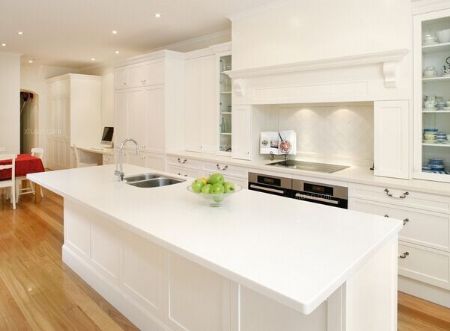During the renovation process, many decoration companies often choose to save the kitchen from water-saving projects in order to save time. They think that the general owners will not want to go to the kitchen for waterproofing, and considering the actual function, the significance of kitchen waterproofing is not significant. So, does the kitchen have to be waterproof in the end? Does the kitchen need to be waterproof? What precautions should be taken when the kitchen is waterproof?
First, the kitchen to do waterproof
The current family water use is more important than the bathroom, kitchen and balcony. In the kitchen, only a small amount of water is splashed on the wall and the ground. Unlike the bathroom, there is a large amount of clear water that spills onto the wall every day. ground. And most of the water on the kitchen floor and walls will be eliminated by evaporation. Only a small part of the water will seep into the walls and floors through the gaps. Over time, it will feel that the ground and the walls will be significantly damp, and Affects wires buried in the wall.
In terms of kitchen waterproofing, the efficiency of use is very low but it is also very important. Another source of water in the kitchen is the water inlet and outlet. There are several types of accidents that cause overflows:
1, the water outlet blocked, causing backwater;
2. Broken water inlet pipe, causing a large amount of water leakage;
3, the water basin is not closed tightly, wash water is splashed on the surface of the water through the joints continue to flow;
Therefore, from the above stages, the kitchen waterproofing project is still very necessary.

Second, the kitchen waterproof should pay attention to what
1, try not to destroy the original waterproof layer
In newly delivered buildings, the floors of bathrooms, bathrooms, and kitchens have waterproof layers according to the relevant regulations. Therefore, if the waterproof layer is not damaged, leakage will not occur after occupancy. The common problem now is that during the renovation, some bathroom bathing facilities will be added and a variety of upper and lower water lines will be re-arranged or moved. It has already seriously damaged the original waterproof layer of the building, but it has not been repaired or re-waterproofed. So that the problem was discovered after the leakage occurred.
The waterproof layer is easily damaged when the floor is redecorated. If it is not repaired in time, leakage will occur in the future, affecting neighbors. Therefore, in the decoration should pay attention to protect the waterproof layer, if accidentally damaged, repair in time to avoid hidden dangers.
2, re-floor tiles to do the ground waterproof
If it is necessary to change the original floor tiles of the bathroom, after the original floor tiles are chiseled away, the ground must be leveled with a cement mortar first, and then the waterproof treatment should be performed so that leakage of the waterproof coating due to uneven thickness can be avoided. Before doing waterproofing, be sure to clean the floor and apply 2 to 3 times repeatedly with a polyurethane waterproof coating.
The seams between the wall and the ground and the pipe seams between the upper and lower water are the most prone to problems. We must urge the workers to handle these corners. The waterproof coating must be applied in place. The decoration team is required to provide cement mulch to the upper and lower water pipes in the kitchen and bathroom. Brush a 10 to 20 cm polyurethane waterproof coating upward from the ground, and then re-do the polyurethane waterproofing on the ground, and add the original waterproof layer to form a composite waterproof layer. To enhance waterproofness.

3, must do wall waterproof
When the kitchen wash things, the water will splash on the adjacent wall. If there is no waterproof layer protection, the partition wall and the diagonal corner wall will be easy to damp and mold. So be sure to waterproof the walls before you apply the wall tiles. In the general waterproofing process, the wall surface is to be treated with a waterproof height of 30 cm. However, for a non-load-bearing lightweight wall, the whole wall should be waterproofed, and at least 1.8 meters high should be achieved.
4, waterproof grooves in the wall should also be waterproof
During the construction process, when the pipeline, floor drain, etc. cross the floor, the waterproof layer around the hole must be seriously constructed. Buried water pipes in the wall, so that a reasonable layout, the laying of water pipes shall be greater than the diameter of the groove, smooth plaster groove, and then brush the groove in the polyurethane waterproof coating.
The floor of the kitchen and toilet must be leaked from the slope to the ground, and the incline should be increased. When the pipelines in the kitchen and bathroom are renovated, the original drainage and sewers and floor drain locations should be avoided as much as possible to avoid leakage due to damage to the waterproof layer due to re-routing of the floor slabs. .
5, with 24 hours 'storage test' acceptance waterproof
After the waterproof project is completed, close the door and the water outlet. Fill the toilet floor with water to a certain liquid level and make a mark. If there is no obvious drop in the liquid level within 24 hours, the roof of the special downstairs home does not occur. Leakage, waterproof to be qualified. If the acceptance is unqualified, the waterproofing project must be redone and re-inspected.
For the acceptance of lightweight wall waterproofing construction, a watering test shall be adopted, even if the water pipe is sprayed continuously from top to bottom on the waterproof paint wall for 3 minutes, and after 4 hours, observe whether the other side of the wall is Infiltration phenomenon will occur, if no penetration phenomenon can be considered wall waterproof construction acceptance.